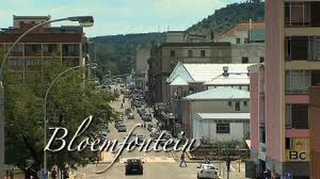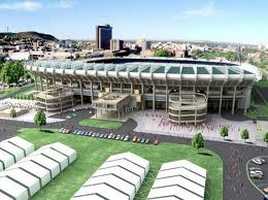Quick Facts: Bloemfontein
- The city of Bloemfontein is the provincial capital of the Free State Province
- Bloemfontein is South Africa's Judicial capital
- The name Bloemfontein can be translated as 'Fountain of Flowers' and the Tswana name for the area is Mangaung 'Place of Cheetahs'
- Bloemfontein was named after a farm built in 1840 by J. Brits
- Franklin Game Reserve
- Soetdoring Nature Reserve
- Willem Pretorius Game Reserve
- Bloemfontein Zoo
- Oliewenhuis Art Gallery: set in a magnificent garden, it is renowned for its excellent collection of South African art
- Bloemfontein National Museum
- National Museum for Afrikaans Literature
- National Women's Memorial and War Museum
- Freshford House Museum
- Naval Hill in Bloemfontein
- Queen's Fort Building
- Bloemfontein Appeal Court
- Fourth Raadsaal
- Old Presidency
- Old Raadsaal
- Tweetoringkerk: Gothic style, Dutch Reformed church built in 1881
Introducing Bloemfontein
The city of Bloemfontein is the provincial capital of the Free State Province and South Africa's Judicial capital making it one of the three national capitals of South Africa. The others being the administrative capital Pretoria and the legislative capital Cape Town. Bloemfontein can be translated as 'Fountain of Flowers' and the Tswana name for the area is Mangaung 'Place of Cheetahs'. Bloemfontein was named after a farm built in 1840 by J. Brits.
In 1854, the Orange Free State was established with Bloemfontein as the capital. During J. Brand's 25 year term as President from 1863, the town of Bloemfontein grew from a struggling frontier town to a wealthy capital city. The Free State city of Bloemfontein is home to many stately old sandstone buildings and its history is connected with the Afrikaners' struggle for independence.
The city of Bloemfontein is located on dry grassland at an altitude of 1,395 metres above sea level. Bloemfontein is home to about 400 000 residents, while the Mangaung Local Municipality has a population of approximately 750 000. The Free State city of Bloemfontein is served by the Bloemfontein Airport.
Bloemfontein is the capital of the Free State Province in South Africa which is also South Africa's judicial capital. The name Bloemfontein can be translated as 'flower spring' or 'fountain of flowers'. Being the capital city of the Free State Province and the judicial capital, Bloemfontein is one of the three national capitals of South Africa. The others being the administrative capital of Pretoria and the legislative capital of Cape Town.
Bloemfontein is popularly and poetically known as "the city of roses", owing to the abundance of these flowers and the annual rose festival held there. The city of Bloemfontein is situated on dry grassland at an altitude of 1,395 metres above sea level. The Mangaung Local Municipality, of which Bloemfontein is part of, has a population of about 750 000. The Bloemfontein Airport serves as an access point to this region of the Free State in South Africa.
Museums in Bloemfontein
National Museum:
the most interesting display in the National Museum of Bloemfontein is the 19th century Bloemfontein street with a cluttered general dealer's store and a pharmacy. Also, a collection of dinosaur fossils can be found.
National Museum for Afrikaans Literature:
this is in the old Government building near the Appeal Court. Displays on Afrikaans literature can be found here as well as the Afrikaans research centre.
National Women's Memorial and War Museum:
this commemorates the 26,000 Afrikaner women and children who died in British Concentration camps during the Anglo-Boer War between 1899-1902. Emily Hobhouse, a British woman who campaigned for better treatment of the prisoners, is buried at the foot of the monument. The War Museum is devoted to the Anglo-Boer War but has some interesting displays.
Freshford House Museum
Game Reserves in / near Bloemfontein, Free State Province (South Africa)
Franklin Game Reserve:
antelopes roam in this area and one can walk around in this reserve
Soetdoring Nature Reserve:
the Soetdoring Nature Reserve borders the Drugerdrif Dam. Black wildebeest and gemsbok roam free but predators such as lions and wild dogs are kept in large camps, a large abundance of bird life can be found here.
Willem Pretorius Game Reserve:
The Willem Pretorius Game Reserve is located 150km north of Bloemfontein. It has a great variety of game and bird life. The Allemanskraal Dam forms the central part of the reserve and on the northern side of this dam is a range of hillocks and on the summit of one of these is Doringberg. Here one can find a well-preserved ruin of a prehistoric settlement. Years ago this belonged to the Leghoya people who built extremely small huts, cattle kraals and walls, all from stone, but without mortar.
Naval Hill in Bloemfontein, Free State Province
Naval Hill in Bloemfontein dominates the city to the north-east from where magnificent views can be enjoyed. Naval Hill was the site of the British naval gun emplacements during the Anglo-Boer War. On the eastern side is a large white horse, a landmark for British cavalry during the war. On the summit the University of Michigan (USA) built an observatory in 1928, but it was closed in 1972, this is a theatre today. The Franklin Game Reserve is on the hilltop where antelopes roam.
Buildings in Bloemfontein, Free State Province (South Africa)
Queen's Fort:
the Queen's Fort in Bloemfontein was built in 1848 and is now restored as a military museum
Appeal Court:
built in 1929
Fourth Raadsaal:
is a brick and sandstone structure constructed in 1893. This now houses the provincial legislature.
Old Presidency:
This is a Victorian style building completed in 1861. The Orange Free State presidents once lived in these spacious chambers. Behind the building is a collection of old agricultural machinery.
Old Raadsaal:
This is the oldest building in the city built by Major Warden in 1849
Tweetoringkerk:
This twin-spired Dutch Reformed church is unique in the country and built in 1881 in Gothic style. A worthwhile visit to see the woodwork around the pulpit and organ is recommended.


(1).jpg)
.jpg)


(1).jpg)
.jpg)
